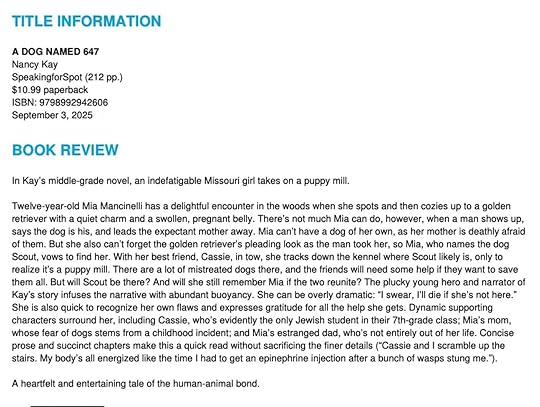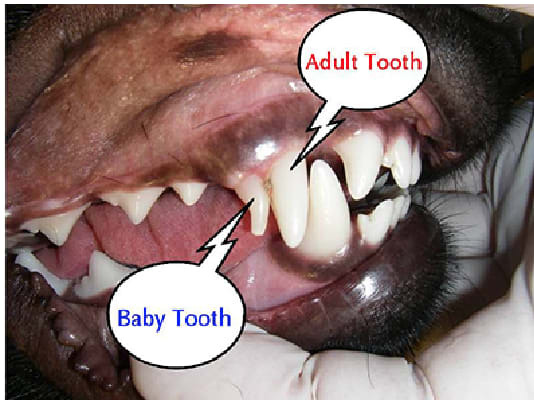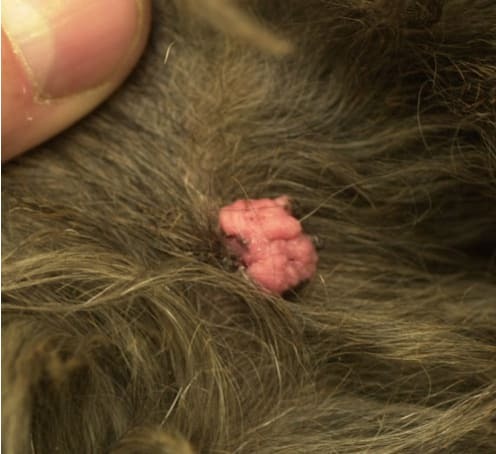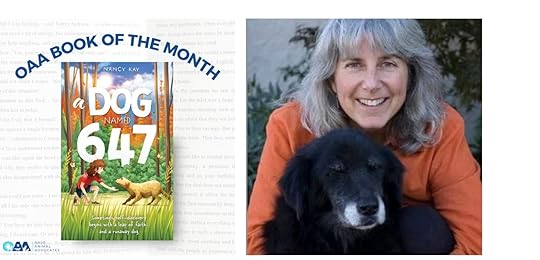Nancy Kay's Blog
October 17, 2025
Kirkus Review of A Dog Named 647
Sometimes in the process of writing, I question, “Am I a good writer?” I think most authors have this thought from time to time.
Kirkus is considered the creme de la creme of professional book reviewers. I ordered a Kirkus review for A Dog Named 647 knowing it would be a gamble. It’s expensive with no guarantee of a positive review.
Speaking for Spot - Dr. Nancy Kay is a reader-supported publication. To receive new posts and support my work, consider becoming a free or paid subscriber.

I received my review yesterday and am so very pleased. Here’s what Kirkus had to say:

I feel a bit like actress Sally Field at the Academy Awards when she said, “You like me! You really, really like me!”
Thanks for sharing in my excitement.
Best wishes to you and your four-legged family members for abundant good health,
Dr. Nancy
DrNancyKay.com
Speaking for Spot - Dr. Nancy Kay is a reader-supported publication. To receive new posts and support my work, consider becoming a free or paid subscriber.
October 13, 2025
Ella Grace
Judy is a Substack fan of mine, and she recently told me about her own dog, Ella. Her story describes the psychological trauma of life in a puppy mill better than anything I could write.
 Ella Grace
Ella GraceElla was a breeding dog rescued from a puppy mill. Hats off to Judy and her husband for their love and patience with this little girl. Here’s what Judy had to say:
Speaking for Spot - Dr. Nancy Kay is a reader-supported publication. To receive new posts and support my work, consider becoming a free or paid subscriber.
“I’m reading A Dog Named 647 and think it should be required reading for every adult! Our last dog, Tessie the Westie, came from a puppy mill, unbeknownst to us. A year after her death, we adopted a little Yorkie, a rescue from a puppy mill. She had been having puppies for five years. The poor thing was a mess, with a cauliflower ear, skin infections, cough, and totally afraid of people and animals. She never made eye contact, paced around the room, lifting her leg to pee on everything. She struggled to get out of my arms when I picked her up.
 Ella Grace at the time of her adoption. Chronic licking caused her fur staining.
Ella Grace at the time of her adoption. Chronic licking caused her fur staining.A small Yorkie is usually adopted in a flash, but ten different parties viewed her and rejected her at the shelter. My husband and I struggled; could we love her or were we just saving her? The shelter worker was about to offer us just about anything to take her. He wanted to give us a senior discount and another discount for adopting a senior dog! It wasn’t a matter of money, it was whether we’d be able to handle the complications. So we took her (and I’ve covered those discounts many times over in donations to the shelter!).
They had called her Gizmo. We renamed her Ella Grace, after a Chicago policewoman who had been killed in a traffic stop, but who loved and saved dogs. On Thursday, we will celebrate three years of loving her. It was difficult to get close to a dog who doesn’t love you back. She has never licked our faces or hands, poked us with her nose for tummy rubs, or willingly sat on our laps. On walks, she used to hide behind my husband’s legs when approached by man or beast. She does not know how to play with toys, even when I’ve tried to teach her by crawling around with toys in my mouth.
So, do we love her? With all our hearts! It has given us such joy to see her personality unfold. She has learned to trust us. Slowly at first. After about a year, she would race to the door when we returned from errands. She’d wiggle her little butt and wag her little cropped tail then run back to her bed. Now, she still races to us but lets us pet her, and I can pick her up from behind and nuzzle her neck. She allows it. After many trips to a canine dermatologist, applications of antibiotics/fungicides twice daily to her ears for months, medicated baths, tablets, etc for the first 7 months we had her…or she had us.
Ellie has bad dreams every day. They are not like the happy ones Tessie and our other dogs used to have, when they would seem like they were running. These are cries like she is struggling and gasping and snorting. We’ll call her name or call her baby or peanut or my monkey, and she’ll wake up. This probably happens all night long and it’s so sad. She used to carry small stuffed toys in her mouth and put them in her bed and lie on them, but not every day anymore. And she goes outside to do her business and races right back into the house. It took about a year of carrying her outside because she wouldn’t climb down one step. She barks a darling little bark when she wants something…like us to be with her inside if we’re outside…or meals. She went from eating God knows what for five years, to frozen raw duck. (and a bit of homemade bread that my husband sneaks to her.) He sometimes says she’s gone from the outhouse to the penthouse.
It’s still not a normal situation. She’s very gentle and sweet and never snarls but she doesn’t appreciate anyone’s attention and gets reclusive. Our son-in-law pays her a lot of attention when he’s here, and she’ll allow it. In fact, she cuddled on the couch with him when he babysat her overnight. He’s the only one. But that’s okay. She’s like a blossom that is unfolding, a little at a time. So, that’s the story of our little Ella Grace.”
“Like a blossom that is unfolding, a little at a time.” This perfectly summarizes this process of rehabilitating a puppy mill breeding dog? Patience is everything. My thanks to Judy and her husband for making one little dog’s life a whole lot better.
Best wishes to you and your four-legged family members for abundant good health,
Dr. Nancy
DrNancyKay.com
Speaking for Spot - Dr. Nancy Kay is a reader-supported publication. To receive new posts and support my work, consider becoming a free or paid subscriber.
October 10, 2025
Spectacular Podcast Host, Arden Moore
I’ve been a guest on many podcasts, but a recent one stands out as the most fun. Arden Moore, the host of “Oh Behave!” is an absolute hoot. Her show earned the recent rank of #3 Best Pet Podcast on the Planet.
Please have a listen to my talk with Arden. I think you’ll enjoy it as much as did.
Speaking for Spot - Dr. Nancy Kay is a reader-supported publication. To receive new posts and support my work, consider becoming a free or paid subscriber.

Best wishes to you and your four-legged family members for abundant good health.
Dr. Nancy
DrNancyKay.com
Speaking for Spot - Dr. Nancy Kay is a reader-supported publication. To receive new posts and support my work, consider becoming a free or paid subscriber.
October 6, 2025
Determining a Dog's Age
How can you tell the age of a dog? The short answer is, easier said than done! Unlike horses, whose teeth have a lifetime of distinctive age-related changes, a dog’s teeth are a reliable indicator of age only for the first 4 to 6 months of life. Beyond 6 months, it’s mostly guesswork.

Here are the few known indicators of the canine aging process.
Speaking for Spot - Dr. Nancy Kay is a reader-supported publication. To receive new posts and support my work, consider becoming a free or paid subscriber.
The teethHere is the puppy dental timeline:
2-4 weeks of age: Deciduous (baby) teeth emerge through the gums. These teeth are small and needle sharp—if ever you’ve had a puppy, you undoubtedly know this.
5-8 weeks of age: All 28 baby teeth are present.
3-6 months of age: Puppies lose their baby teeth, and in come the adult teeth (incisors first, then premolars and canines).
6-7 months of age: All 42 permanent adult teeth are present, clean, and white. These teeth are larger and less sharp than the baby teeth. Sometimes, particularly in smaller breeds, the baby canines don’t fall out, even when the adult canines have grown in (see photo below). In such cases, a veterinarian should remove them in order to prevent issues caused by crowding.

6-12 months of age: The teeth are usually pearly white with no evidence of wear.
12 months of age and older: It’s anyone’s guess. Some dogs develop brown tartar at breakneck speed. Others accumulate very little throughout their lives. The same is true for the amount of wear on the teeth. A dog with worn molars and dental tartar might be 3 or 7 or 12 or anything in between.
Inexact age-related changes in the eyesHave you ever noticed the bluish gray color of an older dog’s pupils? Cataracts that form within the lens of the eye can cause this change. But most of the time, a process called lenticular sclerosis (aka, nuclear scerosis) is at work. Most dogs show this age-related change by 8 years of age or so.
The lens sits directly behind the iris (the colored part of the eye). It is crystal clear, which is why the pupil appears black. Cataracts block the transmission of light to the retina.
Lenticular sclerosis “muddies” vision, but doesn’t block light transmission to the retina. Veterinarians can readily differentiate cataracts from lenticular sclerosis.
Lumps and bumpsBenign lumps and bumps often develop in dogs beginning at approximately 6 years of age. The two most common are:
Sebaceous adenomas: These small, warty-appearing skin growths result from blockage of ducts that carry sebum to the skin surface. Smaller dogs are especially prone- miniature and toy poodles reign supreme when it comes to this age-related change. Sebaceous adenomas don’t need to be removed unless they’re growing rapidly, the dog is bothering them, or they get in the way of grooming clippers.
 Sebaceous adenoma
Sebaceous adenomaLipomas: These benign fatty tumors develop beneath the skin. They can occur anywhere, but their favorite places to grow are the armpit, the inguinal region (the crease between the upper thigh and the belly wall), and along the body wall. They should be removed if they are growing rapidly or interfering with leg motion. Without surgery, some lipomas become huge, as in, “Look at that dog attached to a tumor.” The goal is to remove them before they get too big for surgery.
 Large lipoma
Large lipomaSo, if I examine a dog with lenticular sclerosis and sebaceous adenomas or lipomas, I can say with some certainty that the dog is at least 8 years old. Aging a mature dog without a birth certificate is difficult indeed!
Best wishes to you and your four-legged family members for abundant good health,
Dr. Nancy Kay
DrNancyKay.com
Speaking for Spot - Dr. Nancy Kay is a reader-supported publication. To receive new posts and support my work, consider becoming a free or paid subscriber.
September 29, 2025
Your Dog's Nickname!
Let’s talk nicknames! A dog named Charlie, aka “Shmoopspot Lighting” inspired this post. Dog dad Cliff told me the nickname evolved from the Shmoopy episode of Seinfeld in combination with their cat’s name, Smokestack Lightning.
 Schmoopspot Lighting
Schmoopspot LightingAll of my pets have had nicknames. Little Foot became “Itty Kuflish,” Nellie was “Shmoopy” (but not the Seinfeld Shmoopy), and Quinn goes by “Quinky,” “Squinky,” and “Squinks.” Unlike Charlie’s dad, I don’t have fun explanations about how these nicknames came to be.
Speaking for Spot - Dr. Nancy Kay is a reader-supported publication. To receive new posts and support my work, consider becoming a free or paid subscriber.
 Shmoopy and Squinks
Shmoopy and SquinksWhat about your pets? What are their nicknames? Please share in the comments, including how these names came about. You won’t be able to share photos in the comments, but please do email them to me at vetmama@sonic.net. I look forward to hearing your stories!
Best wishes to you and your four-legged family members for abundant good health,
Dr. Nancy
DrNancyKay.com
Speaking for Spot - Dr. Nancy Kay is a reader-supported publication. To receive new posts and support my work, consider becoming a free or paid subscriber.
September 22, 2025
Matters of the Heart
Just like us, some dogs develop heart disease. What might surprise you is that they don’t experience heart attacks (myocardial infarctions). This is likely because dogs don’t live for the multiple decades necessary for coronary artery plaque to accumulate. (They also don’t smoke cigarettes.)
 Photo by Tracy Anderson on UnsplashCauses of heart disease
Photo by Tracy Anderson on UnsplashCauses of heart disease Speaking for Spot - Dr. Nancy Kay is a reader-supported publication. To receive new posts and support my work, consider becoming a free or paid subscriber.
Breed-Specific Diseases
Certain breeds are particularly predisposed to heart disease. Cavalier King Charles Spaniels are the poster children for this, with more than half developing mitral valve disease by the age of five, and nearly 100% by age ten. Some of the other breeds at increased risk include: boxers, Doberman pinschers, great Danes, cocker spaniels, miniature and toy poodles, and miniature schnauzers.
Congenital (Birth) Defects
This category includes faulty heart valves, defects in the walls between heart chambers, and abnormally configured blood vessels. These defects alter normal blood flow in and around the heart.
Mosquitos transmit this disease in which long spaghetti-like worms set up housekeeping within the heart and arteries that supply the lungs. Left untreated, heartworm disease causes heart and lung issues.
Valvular Disease
Valves open and close to control normal blood flow between the four chambers of the heart. Age-related heart valve degeneration occurs commonly, particularly in small breed dogs. The resulting “valvular insufficiency” can lead to heart failure. Endocarditis, a relatively uncommon disease, results from a bacterial infection that develops on one or more of the heart valves and alters normal blood flow.
Cardiomyopathy
This is disease within the heart muscle causing it to become too thin and flabby (dilated cardiomyopathy) or too thick and stiff (hypertrophic cardiomyopathy). Both conditions impair the normal pumping action of the heart.
Arrhythmias
Arrhythmias are alterations of the normal rhythm of heartbeats. An abnormal beat here and there isn’t a problem, but multiple abnormal beats interfere with blood flow and can produce significant symptoms.
Warning signs of heart diseaseThe heart is a muscular pump responsible for circulating oxygen-rich blood throughout the body. When the pump fails (heart failure), not only can abnormal fluid accumulate in the body, dogs can develop symptoms caused by too little oxygen.
Early warning signs of heart disease can include: increased respiratory rate, coughing, lethargy, restlessness during sleep, and decreased stamina.
More advanced heart disease can cause: weakness, loss of appetite, labored breathing, distention of the abdomen with fluid, blue/purple tinged tongue and gums, fainting, collapse, and even sudden death.
Diagnosis of heart diseaseVeterinarians use the following tests to confirm the diagnosis and type of heart disease:
• A thorough physical examination that includes auscultation of the chest cavity (listening to the heart and lungs with a stethoscope)
• Blood tests, including screening for heartworm disease
• An electrocardiogram (ECG) to evaluate the rhythm of the heartbeats
• Chest X-rays to evaluate the size of the heart and identify abnormal fluid in or around the lungs
• An echocardiogram (ultrasound evaluation of the heart) to evaluate valve function, chamber size, and the strength of heart contractions
Treatment of heart diseaseWhile most canine heart diseases are not curable, they can often be successfully treated, even over a long period of time. Medications are the mainstay of treatment. They’re used to mobilize excess fluid accumulating in the chest, lungs, and/or abdomen. Drugs are also used to decrease the workload on the heart, enhance the strength of heart contractions, and prevent blood clots. Antiarrhythmics are used to treat abnormal heart rhythms, and antiparasitic drugs are used for heartworm disease.
Some types of heart disease are best treated with surgery or a specialized interventional procedure. Examples include placement of pacemakers, repair of a defective heart valve, and correction of birth defects.
PreventionA thorough physical examination performed by a veterinarian once a year (twice yearly for senior dogs) allows for early disease detection. In general, the earlier heart disease is detected, the better the long-term outcome. Given the inherited nature of some heart diseases, certain breeds of dogs should be screened prior to being used for breeding.
Heartworm disease is reliably preventable with monthly heartworm preventive medication.
Questions for your veterinarianIf your four-legged best friend has heart disease, here are some important questions to ask your veterinarian.
• What type of heart disease does my dog have?
• How is it best treated?
• How will I know if treatment is working?
• What symptoms should I be watching for?
• When should I schedule a recheck for my dog?
• Consider asking for a referral to a veterinarian who specializes in cardiology, internal medicine, or radiology. An echocardiogram and other advanced cardiac procedures require specialized equipment and skills.
Has a dog of yours had heart disease? If so, was treatment required?
Best wishes to you and your four-legged family members for abundant good health,
Dr. Nancy
Speaking for Spot - Dr. Nancy Kay is a reader-supported publication. To receive new posts and support my work, consider becoming a free or paid subscriber.
September 19, 2025
Virtual Book Launch: Come One, Come All!
I hope to see you at my virtual launch for this Sunday, September 21st at 2:00 PM PST. Here is the zoom link- .

Best wishes to you and your four-legged family members for abundant good health,
Dr. Nancy
September 15, 2025
In Honor of National Puppy Mill Awareness Day
In honor of National Puppy Mill Awareness Day on September 20th, I’m sharing this delightful surprise of a review of from Ohio Animal Advocates. Given that this review comes from an animal advocacy organization, it means the world to me. I hope you enjoy it almost as much as I did.
 OAA Book of the Month: A Dog Named 647 by Nancy Kay
OAA Book of the Month: A Dog Named 647 by Nancy KaySep 5
Speaking for Spot - Dr. Nancy Kay is a reader-supported publication. To receive new posts and support my work, consider becoming a free or paid subscriber.
Written By Ohio Animal Advocates

Some books break your heart. Others ignite it. Dr. Nancy Kay’s middle-grade novel A Dog Named 647 manages to do both. Inspired by the hidden world of puppy mills, this story follows twelve-year-old Mia, who discovers an emaciated retriever identified only as 647. What begins as one girl’s encounter with a neglected dog quickly unfolds into a journey of courage, friendship, and activism.
Shining a Light on Puppy MillsThrough Mia’s eyes, readers are drawn into the grim reality of commercial breeding facilities — places where dogs are caged, mistreated, and stripped of their identities. Yet the novel isn’t only about cruelty; it’s about resilience. The suspenseful plot, filled with daring choices and tense moments, keeps young readers turning the pages while also teaching them how systemic neglect thrives when left unchallenged.
Friendship at the CoreWhile the dog named 647 is the catalyst for change, Mia’s bond with her best friend Cassie drives the story forward. Their teamwork — from quiet research to bold action — highlights how advocacy often succeeds when rooted in collaboration and trust. The book shows young people that they don’t have to act alone to make a difference.
Lessons Beyond the StoryWhat sets A Dog Named 647 apart is its emphasis on real-world change. Dr. Kay closes the novel with practical ways kids can get involved — from writing letters to leaders to organizing awareness events. The result is part story, part toolkit, and a gentle invitation for readers to turn compassion into action.
Why Read ItFor youth, the novel provides both a gripping narrative and an empowering message: you have the ability to speak up for those without a voice. For adults, it offers insight into how awareness begins at the ground level, often sparked by the passion of young advocates.
At its heart, A Dog Named 647 is a story about empathy — for animals, for friends, and even for people who are caught in broken systems. It reminds us that while one act of kindness might not save the world, it can set change in motion.
Take Action in OhioThe story of A Dog Named 647 highlights the cruelty of commercial dog breeding — a reality that still exists here in Ohio. Right now, legislators have the chance to hold puppy mill breeders accountable and strengthen protections for animals.
Support OAA’s campaign to Hold Puppy Mill Breeders Accountable for Animal Abuse. Contact your state representatives and urge them to take a stand against neglect and cruelty in commercial breeding facilities.
Your voice can help ensure that dogs like 647 are no longer treated as numbers, but as living beings deserving of care and compassion.
Also on National Puppy Mill Awareness Day—my in-person book launch celebration at Berkeley Humane! You can also join my on September 21st. Hope to see you there!
Best wishes to you and your four-legged family members,
Dr. Nancy
Speaking for Spot - Dr. Nancy Kay is a reader-supported publication. To receive new posts and support my work, consider becoming a free or paid subscriber.
September 8, 2025
Why This Nonfiction Author Decided to Write a Novel
Between my books and my blogs, I’ve been writing nonfiction for a long time. Now, after several years spent learning the craft of fiction writing—drum roll please—I’m proud to announce the publication of my !
 Learning to write fiction
Learning to write fictionBecoming adept at writing fiction was quite an endeavor. When I began, I truly had no idea how much I didn’t know! I took classes, read books on plot, character development, and self-editing, worked with editors, and read fiction galore. I was lucky to land in two fabulous writing critique groups with people who skillfully supported me through multiple revisions of my novel. I am deeply grateful to them.
Why I wrote thisHaving witnessed first-hand the nightmare of puppy mills, I’m adamant about doing whatever I can to eradicate them. My main purpose in writing was to expose middle-grade kids to this animal welfare issue. At this age, kids are just beginning to develop awareness of the world around them. In the realm of teaching kids about puppy mills, they are what I fondly refer to as low-hanging fruit!
I tried to write a middle-grade nonfiction book about puppy mills. In fact, I came up with three or four iterations, but after each one I thought, “If I were a middle-grader, no way would I want to read this book!”
So, I dove headfirst into fiction. Multiple revisions later, I present you with , a middle-grade adventure story. Thus far, book reviewers have given it rave reviews.
Of the 12 middle-grade beta readers who provided me with feedback for A Dog Named 647, only five had ever heard of puppy mills. In my book (pun intended), this is a win because seven more kids now know about puppy mills and can share their information with others. My ultimate goal is that as many kids as possible learn about puppy mills by reading A Dog Named 647. In the not too distant future, my hope is that these knowledgeable kids will know how and will want to avoid puppy mill purchases. And we know what happens when demand dwindles…so too does supply.
Where you can find this bookA Dog Named 647 is now available from online book retailers and independent book sellers. If your indie bookstore doesn’t carry it, I’d love if you would ask them to order it for you.
Now, here’s the big favor. Assuming you like my book, please, post five-star review on and .
Book launch celebration!If you’re in the San Francisco Bay Area, please come to my official book launch celebration on September 20th, which happens to be National Puppy Mill Awareness Day. I’d love to see you there!

If you can’t be there in person, I hope you will attend my virtual book launch celebration on September 21st.

Will I right another novel? Who knows, there just might be a sequel someday!
Thank you for supporting my writing. It means the world to me!
Best wishes to you and your four-legged family members for abundant good health,
Dr. Nancy
DrNancyKay.com
September 1, 2025
How To Know If Your Dog Has a Headache?
Have you ever wondered if dogs experience headaches? I feel certain they do. But how can you know? A dog with a painful leg limps. Vomiting and diarrhea suggest a problem in the gut. How do dogs let us know when they have a headache?
 Photo by Łukasz Rawa on UnsplashHeadache Symptoms
Photo by Łukasz Rawa on UnsplashHeadache SymptomsHeadache symptoms in dogs tend to be subtle and resemble what people experience. And all of them can be associated with a gazillion other maladies.
Speaking for Spot - Dr. Nancy Kay is a reader-supported publication. To receive new posts and support my work, consider becoming a free or paid subscriber.
Reclusive behavior (often in dark quiet places)
Squinting can result from the pain of a headache and/or light sensitivity
Diminished appetite
Irritability
Restlessness/pacing
CausesSeveral things ranging from medical issues to environmental stressors can cause headaches in dogs. Here are some potential triggers:
Exposure to noxious substances: smoke, pesticides, cleaning chemicals, loud noises, strong obnoxious smells (certain perfumes do this for me)
Ear and sinus infections
Head trauma
Dental infections, particularly those involving a tooth root and the bone surrounding it.
Diseases of the skull or jaw bones.
Brain diseases such as tumors, inflammation, infection, and increased spinal fluid pressure (signs of a headache can precede the development of neurological symptoms).
PLEASE CHECK OUT MY NEW BOOK, !DiagnosisThink about it—the only way to know a person has a headache is because they tell you. Where is Dr. Dolittle when we need him?
With dogs, a thorough history and physical examination will rule out environmental factors, head trauma, dental disease, and most ear infections. But if this and other testing (blood work, radiographs, ultrasound) come up empty, it’s time to focus on the skull and brain. This may involve an MRI or CT scan and collection of cerebrospinal fluid (spinal tap).
TreatmentTreatment of a dog’s headache involves addressing the underlying cause. In best case scenarios, this might involve removing environmental triggers or a course of antibiotics. If the headache stems from brain disease, the prognosis is a whole lot dicier. Depending on the underlying disease, your veterinarian might discuss antibiotics, antifungals, or anti-inflammatory medications (cortisone). For some brain tumors, your veterinarian might discuss radiation therapy or surgery.
Has your dog ever had what you thought was a headache? If so, did you figure out the cause?
Best wishes to you and your four-legged family members for abundant good health,
Dr. Nancy
DrNancyKay.com
Speaking for Spot - Dr. Nancy Kay is a reader-supported publication. To receive new posts and support my work, consider becoming a free or paid subscriber.



